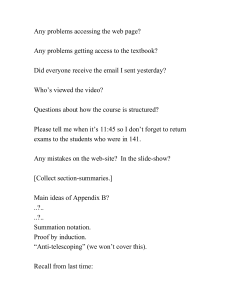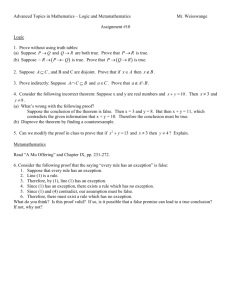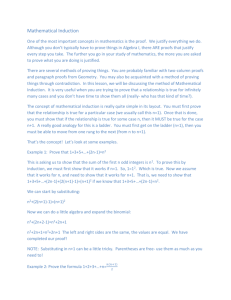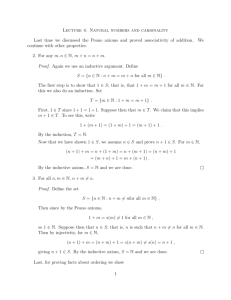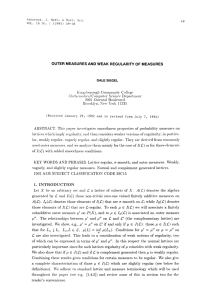Natural Numbers
advertisement
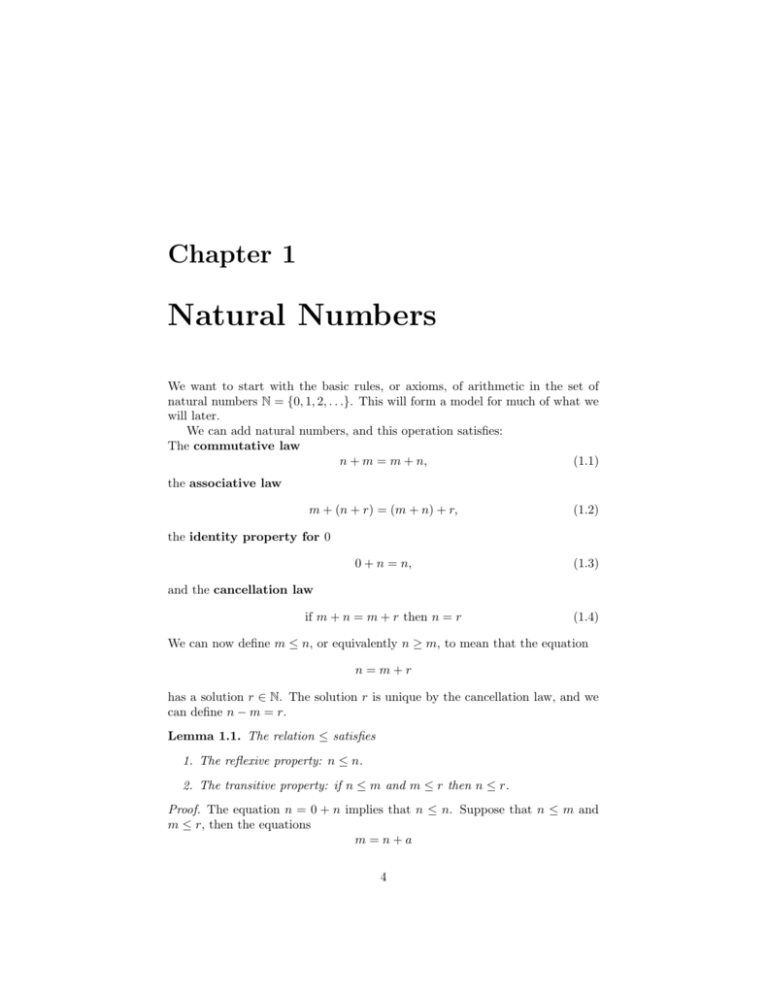
Chapter 1
Natural Numbers
We want to start with the basic rules, or axioms, of arithmetic in the set of
natural numbers N = {0, 1, 2, . . .}. This will form a model for much of what we
will later.
We can add natural numbers, and this operation satisfies:
The commutative law
n + m = m + n,
(1.1)
the associative law
m + (n + r) = (m + n) + r,
(1.2)
the identity property for 0
0 + n = n,
(1.3)
if m + n = m + r then n = r
(1.4)
and the cancellation law
We can now define m ≤ n, or equivalently n ≥ m, to mean that the equation
n=m+r
has a solution r ∈ N. The solution r is unique by the cancellation law, and we
can define n − m = r.
Lemma 1.1. The relation ≤ satisfies
1. The reflexive property: n ≤ n.
2. The transitive property: if n ≤ m and m ≤ r then n ≤ r.
Proof. The equation n = 0 + n implies that n ≤ n. Suppose that n ≤ m and
m ≤ r, then the equations
m=n+a
4
and
r =m+b
have solutions a, b ∈ N. Therefore
r = m + b = (n + a) + b = n + (a + b)
which implies n ≤ r.
We impose a few more rules about ≤ which don’t follow from the definition:
Antisymmetry:
m ≤ n and n ≤ m implies m = n
(1.5)
For any pair m, n ∈ N, m ≤ n or n ≤ m.
(1.6)
Linear ordering:
Well ordering:
Any nonempty subset of N has a least element
(1.7)
It is this last property which makes the natural number special. Often
in proofs or in the construction of algorithms, one has a situation where one
constructs a decreasing sequence of natural numbers x1 > x2 > . . .. The well
ordering property implies that this sequence will eventually stop. We can use
well ordering to prove the principle of mathematical induction.
Theorem 1.2. Let P ⊆ N be a subset.
1. If 0 ∈ P and n + 1 ∈ P whenever n ∈ P , then P = N.
2. If 0 ∈ P and n ∈ P whenever 0, 1, . . . n − 1 ∈ P then P = N.
In practice, this means that to prove a statement for all natural numbers,
say
n(n + 1)
,
2
it’s enough to check it for 0 (the initial step) and then check that the statement
holds for n + 1 if it holds for n (the induction step). The second part gives
a form of induction that’s less familiar but also useful. To see this in action,
let’s prove the above equation using this form. It certainly holds when n = 0.
Suppose that, we know the equation
0 + 1 + 2...n =
m(m + 1)
2
holds for all natural numbers m = 0, 1, . . . n − 1. Take m = n − 1 above, after
adding n to both sides and simplifying, we establish the equation for hold for
m = n. Therefore it holds for all n.
Before giving the proof, we make a few observations. 1 can be defined to be
the least element of the set of nonzero natural numbers. (If we wanted to be
fussy, we should really impose the nonemptiness of this set as a rule.) Therefore
n 6= 0 implies that n ≥ 1, from which it follows that n = m + 1 for some m ∈ N.
0 + 1 + 2...m =
5
Proof. 1) Suppose that P 6= N, then the complement F = N − P = {x ∈ N|x ∈
/
P }. is nonempty. Let n ∈ F be the smallest element. Then n 6= 0 since 0 ∈ P .
Therefore n = m + 1. Since m < n it follows that m ∈ P . This implies that
m ∈ P . By assumption, m + 1 would have to lie in P . But this would be a
contradiction.
2) We choose F and n ∈ F as above. Since n is minimal, it follows that
0, 1, . . . n − 1 ∈ P . Therefore n ∈ P which is again a contradiction.
In a more systematic development of natural numbers, we would define multiplication in terms of the more basic operations. The idea is that
nx = x + x + . . . x (n times)
To avoid confusion, let us denote the right hand side by multx (n). We reformulate this as an inductive, or recursive, definition:
½
0 if n = 0
(1.8)
multx (n) =
multx (n − 1) + x otherwise
This makes sense because of the following:
Proposition 1.3. Given a set A, an element a ∈ A, and a function g : N×A →
A, there exists a unique function f : N → A satisfying
½
a if n = 0
f (n) =
g(n − 1, f (n − 1)) otherwise
One make even more elaborate recursive definitions, where f (n) is specified
for some initial values of n, and then a formula for general f (n) depending
on earlier values. Such a recursive definition is theoretically useful for establish properties of the function. It also has practical value, in that it leads to
a method for computing the function. Namely, one systematically calculates
f (0), f (1), . . .. At each stage the required information for calculating f (n) has
already been given.
For example the Fibonacci numbers are given by the sequence
1, 1, 2, 3, 5, 8 . . .
The pattern is that each number in the sequence is the sum of the previous two.
So the nth Fibonacci number is given by
½
1 if n = 0 or n = 1
f ib(n) =
f ib(n − 2) + f ib(n − 1) otherwise
1.4
Exercises
1. Let multm (n) be defined as in (1.8). Prove that multm+1 (n) = multm (n)+
n by induction on n (treating m as constant).
6
2. With the help of the previous problem, prove that multm (n) = multn (m)
by induction on n (treating m as constant). This is the commutative law
for multiplication: nm = mn.
For the following problems assume all the standard rules of highschool
algebra.
3. Let
where
1
F (n) = √ [rn+1 − sn+1 ]
5
√
√
1− 5
1+ 5
, s=
r=
2
2
(a) Calculate f ib(n) and F (n) by hand for n = 0, 1, 2, and check that
f ib(n) = F (n) for these values.
(b) Repeat above for n = 3, 4, 5 using Maple, appendix B.
4. Prove that f ib(n) = F (n) for all n ∈ N.
7
Chapter 2
Principles of Counting
Natural numbers are important because they can be used to count. Given a
natural number n ∈ N, let
[n] = {x ∈ N | x < n} = {0, 1, 2, . . . n − 1}
Let X be set, then we say that X has n elements, or that |X| = n if there exists
a one to one correspondence f : [n] → X (see appendix A for definitions of these
concepts). If no such n exists, then we say that X is an infinite set. The first
problem is to show that |X| cannot have multiple values. This is guaranteed by
the following:
Theorem 2.1. If there exists a one to one correspondence f : [n] → [m], then
n = m.
Proof. We will prove this by induction on the minumum M of n and m. Suppose
that M is zero. Then n = 0 or m = 0. If n = 0, then [n] = ∅, so that f : ∅ → [m]
is onto. It follows that m = 0. If m = 0, then f −1 : ∅ → [n] is onto, so that
n = 0.
Assume that M > 0 and that the theorem holds for M − 1. Then define
g : [n − 1] → [m − 1] by
½
f (i)
if f (i) < f (n − 1)
g(i) =
f (i) − 1 if f (i) > f (n − 1)
This is a one to one correspondence, therefore m − 1 = n − 1, which implies
m = n.
Lemma 2.2. If a finite set X can be written as a union of two disjoint subsets
Y ∪ Z (disjoint means their intersection is empty), then |X| = |Y | + |Z|.
Proof. Let f : [n] → Y and g : [m] → Z be one to one correspondences. Define
h : [n + m] → X by
½
f (i)
if i < n
h(i) =
g(i − n) if i ≥ n
This is a one to one correspondence.
8
A partition of X is a decomposition of X as a union of subsets X = Y1 ∪
Y2 ∪ . . . Yn such that Yi and Yj are disjoint whenever i 6= j.
Corollary 2.3. If X = Y1 ∪ Y2 ∪ . . . Yn is a partition, then |X| = |Y1 | + |Y2 | +
. . . |Yn |.
Corollary 2.4. If f : X → Y is a function, then
X
|f −1 (y)|
|X| =
y∈Y
Proof. The collection {f −1 (y)} forms a partition of X.
Next consider the cartesian product of two finite sets appendix A.
Theorem 2.5. If X and Y are finite sets, then |X × Y | = |X||Y |.
Proof. Let p : X × Y → Y be the projection map defined by p(x, y) = y. Then
p−1 (y) = {(x, y) | x ∈ X}
and (x, y) → x gives a one to one correspondence to X. Therefore, by the
previous corollary,
X
|p−1 (y)| = |Y ||X|
|X × Y | =
y∈Y
We want to outline a second proof. For this proof, we assume that X = [m]
and Y = [n] for some m, n ∈ N. Then we have to construct a one to one
correspondence between [m] × [n] and [mn]. We define a map F (q, r) = qn + r
from [m] × [n] → N. Since q ≤ m − 1 and r ≤ n − 1, we have
F (q, r) < (m − 1)n + n = mn
So we can regard F is a map from [m] × [n] → [mn] which can visualized using
the table
0
1
...
n-1
F
0
0
1
...
n-1
1
n
n+1 . . .
2n-1
..
.
...
m-1 (m-1)n . . .
mn-1
The fact that F is a one to one correspondence is proved by the next theorem
which is usually called the “division algorithm”. Although it’s not an algorithm
in the technical sense, it is the basis of the algorithm for long division that one
learns in school.
9
Theorem 2.6. Let a, n ∈ N with n 6= 0, then there exists a unique pair of
natural numbers q, r satisfying
a = qn + r, r < n
Furthermore if a < mn, then q < m.
r is called the remainder of division of a by n.
Proof. Let
R = {a − q 0 n | q 0 ∈ N and q 0 n ≤ a}
Let r = a − qn be the smallest element of R. Suppose r ≥ n. Then a = qn + r =
(q + 1)n + (r − n) means that r − n lies in R. This is a contradiction, therefore
r < n.
Suppose that a = q 0 n + r 0 with r 0 < n. Then r 0 ∈ R so r 0 ≥ r. Then
qn = q 0 n + (r 0 − r) implies that n(q − q 0 ) = r 0 − r. So r 0 − r is divisible by n. On
the other hand 0 ≤ r 0 − r < n. But 0 is the only integer in this range divisible
by n is 0. Therefore r = r 0 and qn = q 0 n which implies q = q 0 .
For the last part, suppose that a < mn. If q ≥ m, then a ≥ qn ≥ mn which
is a contradiction.
Since the r and q above are unique (given a and n), we can view them as functions r(a, n) and q(a, n). In Maple, these functions are denoted by irem(a, n)
and iquo(a, n) respectively.
2.7
Exercises
1. If Y ⊆ X, prove that |X| = |Y | + |X − Y |.
2. Given finite sets Y, Z. Prove that |Y ∪ Z| = |Y | + |Z| − |Y ∩ Z|.
3. Suppose that a dice is rolled twice.
a) In how many ways can a five or six be obtained on the first role?
b) In how many ways can a five or six be obtained in either (or both)
roll(s)?
c) In how many ways can the same number be rolled twice?
d) In how many ways can different numbers be obtained for each roll?
4. Prove corollary 2.3 by induction.
5. Suppose that m = n = 101. What’s F −1 (5234)?
10


